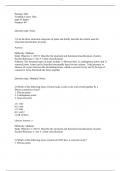Biol 235 9 - Study guides, Class notes & Summaries
Looking for the best study guides, study notes and summaries about Biol 235 9? On this page you'll find 47 study documents about Biol 235 9.
Page 4 out of 47 results
Sort by
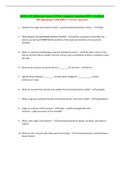
-
BIOL 235 Midterm Exam 2 With Complete Solution(100% Verified) 185 Questions with 100% Correct Answers
- Exam (elaborations) • 20 pages • 2023
-
- $10.49
- + learn more
BIOL 235 Midterm Exam 2 With Complete Solution(100% Verified) 185 Questions with 100% Correct Answers Document Content and Description Below BIOL 235 Midterm Exam 2 With Complete Solution(100% Verified) 185 Questions with 100% Correct Answers 1. between the origin and insertion which is usually located proximally in limbs ? - Origi n 2. What happens during REVERSE MUSCLE ACTION? - specific movements of the body the actions are reversed THEREFOR the positions of the origin and insertion of a mu...
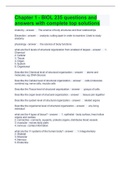
-
Chapter 1 - BIOL 235 questions and answers with complete top solutions
- Exam (elaborations) • 6 pages • 2023
- Available in package deal
-
- $11.49
- + learn more
Chapter 1 - BIOL 235 questions and answers with complete top solutions Anatomy The science of body structures and their relationships Dissection analysis; cutting apart in order to examine. Used to study anatomy physiology the science of body functions what are the 6 levels of structural organization from smallest of largest. 1. Chemical 2. Cellular 3. Tissue 4. Organ 5. System 6. Organismal Describe the Chemical level of structural organization. atoms and ...

-
BIOL 235 Midterm Exam 2 With Complete Solution(100% Verified)
- Exam (elaborations) • 20 pages • 2022
-
- $10.99
- + learn more
BIOL 235 Midterm Exam 2 With Complete Solution(100% Verified) 185 Questions with 100% Correct Answers 1. between the origin and insertion which is usually located proximally in limbs ? - Origin 2. What happens during REVERSE MUSCLE ACTION? - specific movements of the body the actions are reversed THEREFOR the positions of the origin and insertion of a muscle are switched 3. What is a mechanical advantage using the example of a lever? - if the load is closer to the fulcrum and the effort i...
BIOL 235/BIOL235-Unit 9 Test Bank: Human Anatomy and Physiology: Biology (Athabasca University)
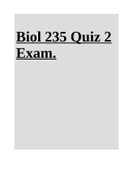
-
Biol 235 Quiz 2 Exam.
- Exam (elaborations) • 29 pages • 2022
- Available in package deal
-
- $10.49
- + learn more
Biol 235 Quiz 2 Exam. The relationship between these muscles when bowing you head is C) The sternocleidomastoid is the prime mover and the splenius cervicis is the antagonist. The principle muscles that are primarily responsible for causing a given action about a joint are referred to as the agonist muscles or the prime movers. The muscle that opposes that movement and returns the body part to the original position is called the antagonist muscle. A muscle which stabilizes a joint around ...
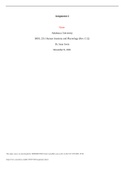
-
BIOL 235: Human Anatomy and Physiology (Rev. C12)
- Exam (elaborations) • 6 pages • 2023
-
- $18.99
- + learn more
BIOL 235: Human Anatomy and Physiology (Rev. C12) With regards to effort and load, describe the main difference between a lever operating with a mechanical advantage versus a lever operating at a mechanical disadvantage Name and describe the locations and actions of the muscles typically used in breathing. Describe how K+ permeability and Na+/K+ pump activity contribute to the unequal distribution of ions and charges, thereby establishing a resting membrane potential. 4. Describe the differ...

-
BIOL 235 CHAPTER 9 – JOINTS full update exam short notes Athabasca University
- Exam (elaborations) • 32 pages • 2022
- Available in package deal
-
- $8.29
- + learn more
BIOL 235 CHAPTER 9 – JOINTS full update exam short notes Athabasca University
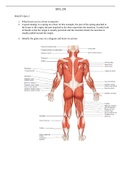
-
Exam (elaborations) Biol 235 Quiz 2 (RATED A) Questions and Answer solutions | 100% out of 100% | Athabasca University Biol235 Quiz 2 1. What forces act on a lever in muscles 2. A good analogy is a spring on a door. In this example, the part of the spring
- Exam (elaborations) • 28 pages • 2022
-
- $16.99
- + learn more
Exam (elaborations) Biol 235 Quiz 2 (RATED A) Questions and Answer solutions | 100% out of 100% | Athabasca University Biol235 Quiz 2 1. What forces act on a lever in muscles 2. A good analogy is a spring on a door. In this example, the part of the spring attached to the frame is the origin; the part attached to t he door represents the insertion. A useful rule of thumb is that the origin is usually proximal and the insertion distal; the insertion is usually pulled toward the origin. 3. Identi...
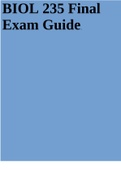
-
BIOL 235 Final Exam Guide
- Exam (elaborations) • 41 pages • 2022
-
- $12.99
- + learn more
BIOL 235 Final Exam Guide. Chapter 19 The Cardiovascular System: The Blood Objectives After completing this chapter, you should be able to 1. describe the functions of blood. 2. describe the physical characteristics and principal components of blood. 3. list the major components of plasma and explain their importance. 4. explain the origin of blood cells. 5. describe the structure, functions, life cycle and production of red blood cells. 6. describe the structure, functions and produc...

-
BIOL 235: Assignment 3 (2018): Athabasca University |( 100% VERIFIED ANSWERS, ALREADY GRADED A)
- Exam (elaborations) • 20 pages • 2020
- Available in package deal
-
- $25.49
- 1x sold
- + learn more
BIOL 235: Assignment 3 (2018): Athabasca University Assignment 3: Biology 235: Human Anatomy and Physiology (2018) Weight: 5% Minimum Pass Grade: 50% 1. Fill in the words or phrases that best complete each sentence. Be as specific as possible. a. Erythrocytes contain the enzyme ______, which catalyzes the conversion of metabolically produced CO2 and water into ______. b. Most old erythrocytes are removed from circulation and destroyed by cells called ______, as they rupture passing through the ...

Study stress? For sellers on Stuvia, these are actually golden times. KA-CHING! Earn from your study resources too and start uploading now. Discover all about earning on Stuvia

